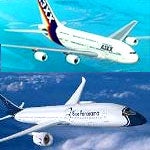The scandal involving Noel Forgeard, chief executive of European aerospace consortium EADS, coupled with the delay in the production of the A380 super jumbo, the firm’s star model, have exposed an internal crisis in the aerospace manufacturer, just when it appeared to be expanding its supremacy over Boeing. After several decades during which Boeing was the leading producer of aircraft, Airbus managed in 2003 to deliver more planes than its competitor. In addition to the crisis at EADS headquarters, Boeing’s new strategic approach and the fact that some of its models are better adapted to the realities of the aerospace business have all contributed to Boeing’s success in regaining the crown that it lost three years ago. Nevertheless, experts agree that this is merely another battle in the long war being waged by the world’s only two global aircraft manufacturers. From now through 2024, the sector will record sales of $2.1 trillion, thanks to annual increases of 4.8% in the number of passengers and 6.2% in the volume of air cargo.

Sign up to stay informed about our latest article releases.